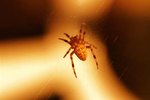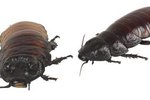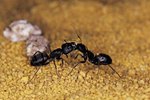
Determining whether a ladybug is male or female has nothing to do with the size or number of black spots on the insect's orange body. Both sexes have these spots. The male is generally slightly smaller than the female. The ladybug's reproductive organs share the abdomen, along with the digestive and respiratory organs.
Ladybug Markings
While their bright orange coloring and black spots make the ladybug one of the world's most identifiable insects, the color and pattern serve a purpose in nature. Other insect predators avoid ladybugs because many species of these colorful insects can release a bad-smelling chemical on potential attackers. Because of that, predators avoid insects colored like the ladybug, including those species that don't have the ability to spread an odor.
Ladybug Reproduction
After breeding, female ladybugs lay orange or yellow-colored eggs underneath leaves. These eggs hatch five to eight days later. The larvae consume aphids, also the adult ladybug's primary food, for the next two weeks. During this period, the larvae experience several molts. After the final molt, larvae attach to a stem or leaf and form a pupa. The adult emerges when the temperature rises, which is why you might see ladybugs out during a winter warm spell.
References
Photo Credits
-
Thinkstock Images/Stockbyte/Getty Images
Writer Bio
Jane Meggitt has been a writer for more than 20 years. In addition to reporting for a major newspaper chain, she has been published in "Horse News," "Suburban Classic," "Hoof Beats," "Equine Journal" and other publications. She has a Bachelor of Arts in English from New York University and an Associate of Arts from the American Academy of Dramatics Arts, New York City.




